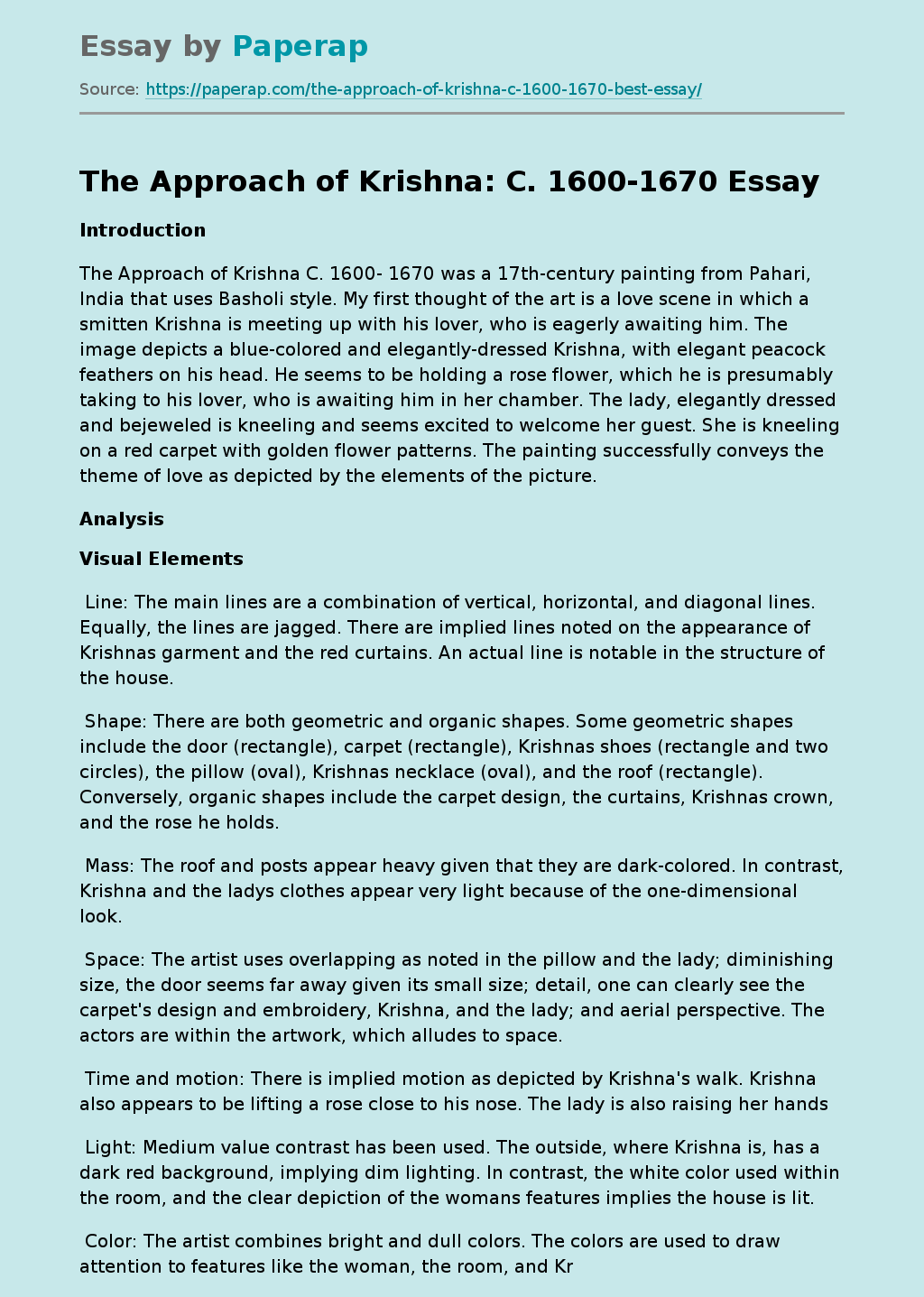Introduction
The Approach of Krishna C. 1600- 1670 was a 17th-century painting from Pahari, India that uses Basholi style. My first thought of the art is a love scene in which a smitten Krishna is meeting up with his lover, who is eagerly awaiting him. The image depicts a blue-colored and elegantly-dressed Krishna, with elegant peacock feathers on his head. He seems to be holding a rose flower, which he is presumably taking to his lover, who is awaiting him in her chamber.
The lady, elegantly dressed and bejeweled is kneeling and seems excited to welcome her guest. She is kneeling on a red carpet with golden flower patterns. The painting successfully conveys the theme of love as depicted by the elements of the picture.
Analysis
Visual Elements
Line: The main lines are a combination of vertical, horizontal, and diagonal lines. Equally, the lines are jagged. There are implied lines noted on the appearance of Krishnas garment and the red curtains.
An actual line is notable in the structure of the house.
Shape: There are both geometric and organic shapes. Some geometric shapes include the door (rectangle), carpet (rectangle), Krishnas shoes (rectangle and two circles), the pillow (oval), Krishnas necklace (oval), and the roof (rectangle). Conversely, organic shapes include the carpet design, the curtains, Krishnas crown, and the rose he holds.
Mass: The roof and posts appear heavy given that they are dark-colored. In contrast, Krishna and the ladys clothes appear very light because of the one-dimensional look.
Space: The artist uses overlapping as noted in the pillow and the lady; diminishing size, the door seems far away given its small size; detail, one can clearly see the carpet’s design and embroidery, Krishna, and the lady; and aerial perspective. The actors are within the artwork, which alludes to space.
Time and motion: There is implied motion as depicted by Krishna’s walk. Krishna also appears to be lifting a rose close to his nose. The lady is also raising her hands
Light: Medium value contrast has been used. The outside, where Krishna is, has a dark red background, implying dim lighting. In contrast, the white color used within the room, and the clear depiction of the womans features implies the house is lit.
Color: The artist combines bright and dull colors. The colors are used to draw attention to features like the woman, the room, and Krishna. The complementary colors increase the visibility of the objects.
Texture: The texture is implied. The texture is tight and controlled.
Principles of Design
Unity and variety: Unity is created through the consistent use of similar shapes like ovals and rectangles. The geometric and organic shapes also add variety, as well as the light contrasts.
Balance: The balance is asymmetrical. The room, brightly colored, is balanced by the empty space on Krishna’s side and the proximity of Krishna, who is moving towards the room.
Emphasis and subordination: Krishna, the carpet, and the lady are emphasized. Conversely, objects that have been subordinated are the door, and curtains, and exterior of the house.
Directional forces: The eyes of the two lovers aid in creating direction. Krishna is staring at the woman, who is looking at and holding out her hands to him. She is also kneeling in his direction, while Krishnas feet are facing the direction of the house.
Contrast: Variation of bright and dull colors and scale creates contrast in the picture.
Repetition and rhythm: There is repeated use of rectangular-shaped objects like the door, carpet, and frame of the house. These repetitions bring it harmony in the picture.
Scale and proportion: The art size is quite small (23.4 x 32.4 cm). Thus, the art pieces appear smaller than they are. The elements appear real, especially the woman. As a god, Krishnas color makes him unique and supernatural.
Conclusion
The painting successfully conveys the theme of love as depicted by the elements of the picture. My initial thought of the art piece was a depiction of a love scene in which a smitten Krishna is meeting up with his lover, who is eagerly awaiting him. After analyzing the picture, I am more convinced of my notion that the picture conveys love. The directional forces are especially convinced as the two lovers are facing each other.
Work Cited
Preble, Duane Emeritus, Sarah Preble, and Patrick L. Frank. Art Appreciation. New York: Pearson, 2014
The Approach of Krishna: C. 1600-1670. (2019, Dec 07). Retrieved from https://paperap.com/the-approach-of-krishna-c-1600-1670-best-essay/

